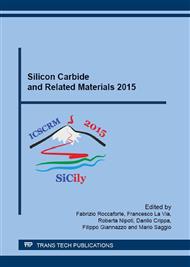p.677
p.681
p.685
p.689
p.693
p.697
p.701
p.705
p.711
Interface Analysis of P-Type 4H-SiC/Al2O3 Using Synchrotron-Based XPS
Abstract:
In this paper, the interface between Al2O3 and p-type 4H-SiC is evaluated using x-ray photoelectron spectroscopy (XPS) measurements. These studies are made on dielectric-semiconductor test structures with Al2O3 as dielectric with different pre-and post-deposition treatments. XPS measurements on the as-deposited samples with two different pre-surface cleaning have shown no formation of a SiO2 interlayer. However, after the post deposition rapid thermal annealing (RTA) at 1100 °C in N2O for 60s, a SiO2 interlayer is formed. The surface band bending was determined from Si 2p core level peak shifts measured using XPS. These results suggest that Al2O3 deposited on the p-type 4H-SiC have a net positive oxide charge which is complementary to that of n-type 4H-SiC. From these shifts it was found that the as-deposited RCA cleaned sample had an oxide charge of 5.6×1013 q/cm-2, as compared to standard cleaned samples, having 4.6×1013 q/cm-2. A further reduction in oxide charge was observed after annealing at 1100 °C in N2O, down to a value of 4×1013 q/cm-2.
Info:
Periodical:
Pages:
693-696
Citation:
Online since:
May 2016
Price:
Сopyright:
© 2016 Trans Tech Publications Ltd. All Rights Reserved
Share:
Citation:


